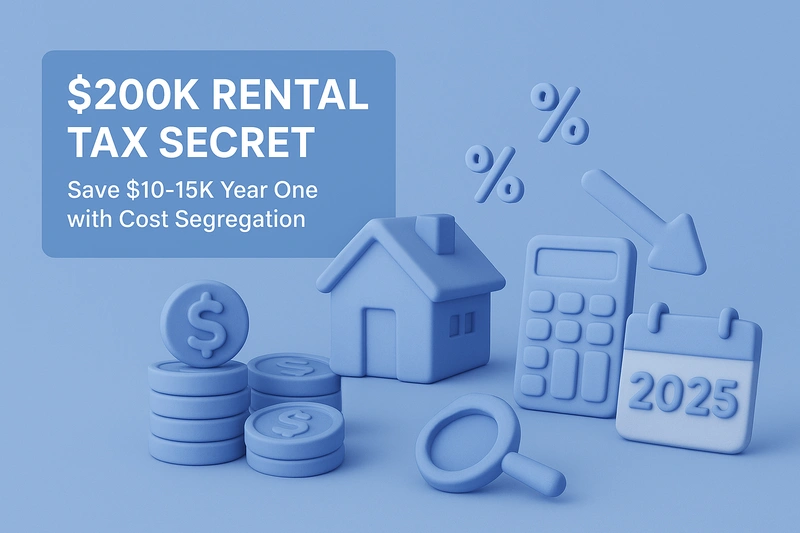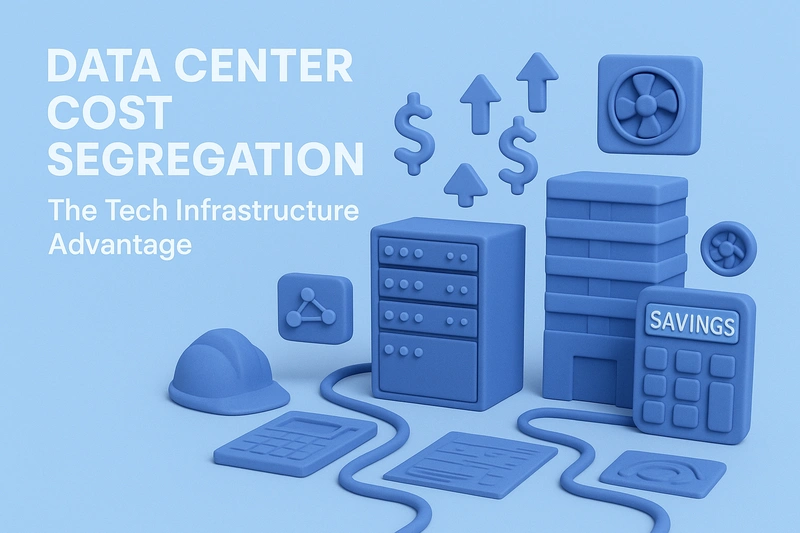Most investors assume cost segregation services only benefit large commercial properties. This assumption costs them thousands in annual tax savings. A $200K rental house can accelerate 20-30% of its depreciable basis into year one through proper cost segregation analysis.
With permanent 100% bonus depreciation now in effect, these accelerated deductions translate directly to immediate cash flow.
Traditional residential rental depreciation spreads deductions over 27.5 years. Cost segregation identifies components eligible for 5, 7, and 15-year recovery periods. When combined with bonus depreciation, investors can deduct these shorter-life assets immediately.
For small property owners managing 1-5 rentals, this strategy delivers tax savings that fund portfolio expansion.
What Makes Small Property Cost Segregation Work Now
Three factors converge to make small property cost segregation exceptionally valuable in 2025.
First, the Big Beautiful Bill's permanent 100% bonus depreciation eliminates timing concerns. Second, technology has reduced study costs for residential rentals. Third, increased IRS acceptance of detailed component analysis supports aggressive but compliant segregation strategies.
Breaking Down a $200K Rental House
Consider a typical $200K single-family rental purchase:
- Land value: $40,000 (20% - non-depreciable)
- Building/Improvements: $160,000 (depreciable basis)
R.E. Cost Seg analysis typically identifies these accelerated depreciation opportunities:
- 5-year property (10-15%): $16,000-24,000
- 7-year property (5-8%): $8,000-12,800
- 15-year property (5-10%): $8,000-16,000
- Total accelerated depreciation: $32,000-52,800
This represents 20-33% of the property's depreciable basis eligible for immediate deduction through 100% bonus depreciation.
Is a $200K rental house worth the cost segregation study investment?
With permanent bonus depreciation, accelerating $40,000 in deductions saves $10,000-14,800 in federal taxes (25-37% brackets). R.E. Cost Seg typically charges $2,800-$5,000 for residential studies. The return on investment often exceeds 250% in year one.
Small property investors previously faced difficult calculations balancing study costs against phasing bonus depreciation rates. The Big Beautiful Bill eliminates this complexity. Every qualifying component identified receives full bonus depreciation treatment.
For investors acquiring multiple properties or conducting substantial renovations, the savings multiply across their portfolio.
Why Small Properties Excel with Cost Segregation
Small rental properties contain proportionally higher percentages of 5-year property compared to large commercial buildings. In a $200K rental house, appliances represent 2-3% of total value versus 0.5% in million-dollar properties. This concentration of short-life assets amplifies bonus depreciation benefits.
Kitchen appliances, flooring, fixtures, and landscaping comprise larger value percentages in modest homes. These components qualify for accelerated depreciation through proper cost segregation analysis. R.E. Cost Seg consistently identifies 20-30% of small residential property values as eligible for acceleration.
Real Example: $200K Single-Family Rental Analysis
- Purchase Price: $200,000
- Land Value: $40,000
- Depreciable Basis: $160,000
Standard Depreciation Method:
- Annual deduction: $5,818
- Tax savings (28% bracket): $1,629 yearly
With Cost Segregation Services:
- 5-year property identified (12%): $19,200
- 7-year property identified (7%): $11,200
- 15-year property identified (8%): $12,800
- Year 1 bonus depreciation: $43,200
- Tax savings (28% bracket): $12,096
- Additional first-year benefit: $10,467
This $10,467 represents immediate cash available for reinvestment, property improvements, or debt reduction. Small investors leveraging these savings across multiple properties accelerate portfolio growth substantially.
How does cost segregation affect passive activity losses?
Real estate professional status allows unlimited loss deductions against ordinary income. Without this designation, active participants can deduct up to $25,000 in rental losses annually (phasing out between $100,000-150,000 AGI). Cost segregation creates larger paper losses through accelerated depreciation while maintaining positive cash flow.
Investors not meeting real estate professional requirements carry forward unused losses. These suspended losses offset future rental income or release upon property sale. Strategic timing of cost segregation studies maximizes tax efficiency based on individual income situations.
Components That Qualify in Small Rental Properties
5-Year Property (Maximum Bonus Depreciation Impact)
R.E. Cost Seg identifies these common residential components as 5-year property:
- Kitchen appliances: refrigerator, dishwasher, microwave, garbage disposal
- Laundry equipment: washer, dryer, utility sink
- Window treatments: blinds, curtains, shutters
- Floor coverings: carpeting, vinyl planking (not permanently affixed)
- Security systems and cameras
- Decorative light fixtures
- Ceiling fans
These items qualify for immediate 100% bonus depreciation deduction when properly documented through engineering-based analysis.
15-Year Land Improvements
External improvements represent significant acceleration opportunities:
- Concrete driveways and walkways
- Fencing and gates
- Landscaping and irrigation systems
- Outdoor lighting and electrical
- Retaining walls
- Patios and decks (attached)
Site visits document these improvements for accurate classification. R.E. Cost Seg engineers photograph and measure each component during property inspections.
Do short-term rentals qualify?
Properties rented less than 30 days average qualify as commercial property with 39-year depreciation. However, more aggressive cost segregation percentages often apply, potentially accelerating 25-35% of basis. Short-term rental properties typically contain more furnishings and amenities qualifying as 5-year property.
Portfolio Multiplication Strategy
Consider five $200K rental houses totaling $1 million in acquisition costs with a 20% land value:
- Combined 5-year property (12%): $96,000
- Combined 7-year property (7%): $56,000
- Combined 15-year property (8%): $64,000
- Total bonus depreciation: $216,000
- Tax savings at 32% rate: $69,120
Volume discounts reduce per-property study costs when analyzing multiple properties simultaneously.
What about properties owned for years?
Look-back studies capture missed depreciation from prior years. File Form 3115 with your current tax return to claim the adjustment. This automatic accounting method change requires no IRS pre-approval. The entire catch-up depreciation adjustment flows through the current year return. Properties placed in service after September 27, 2017, qualify for bonus depreciation on identified components.
Strategic Considerations for Small Investors
Optimal Timing for Cost Segregation Studies
Execute cost segregation services during high-income years to maximize tax bracket arbitrage. A $40,000 bonus depreciation deduction saves $14,800 at the 37% rate versus $8,800 at the 22% rate. Coordinate studies with other taxable events like business sales, stock option exercises, or retirement account conversions.
Property improvements and renovations create additional cost segregation opportunities. Kitchen remodels, HVAC replacements, and flooring upgrades qualify for immediate deduction through 100% bonus depreciation. Document all improvement costs separately from original basis calculations.
State Tax Considerations
Not all states conform to federal bonus depreciation rules. States like California, New York, and Pennsylvania require separate depreciation calculations. Some states completely decouple from federal bonus depreciation, reducing overall tax benefits. Consult state-specific rules before implementing cost segregation strategies. Property tax assessments typically remain unaffected by federal depreciation methods.
Depreciation Recapture Planning
Understanding recapture prevents future tax surprises. Section 1245 property (5 and 7-year assets) faces ordinary income tax rates upon sale, up to depreciation taken. Section 1250 property (15 and 27.5-year assets) caps recapture at 25%. Strategic hold periods and 1031 exchanges defer these taxes indefinitely.
How does recapture work when selling?
Selling after claiming $40,000 in accelerated depreciation triggers recapture tax. If $25,000 came from 5-year property and $15,000 from 15-year property, expect approximately $9,250 in recapture tax (assuming 37% and 25% rates). Compare this to years of enhanced cash flow. Most investors find the trade-off favorable.
1031 exchanges defer all recapture and capital gains taxes. The replacement property inherits the depreciation schedule. R.E. Cost Seg performs studies on replacement properties to identify new acceleration opportunities.
Taking Action: Your Next Steps
Calculate potential savings before engaging cost segregation services:
- Multiply depreciable basis by 25-30% (typical acceleration percentage)
- Multiply result by your marginal tax rate
- Compare savings to study cost
A $160,000 depreciable basis yields approximately $40,000 in accelerated depreciation. At a 32% tax rate, this creates $12,800 in immediate tax savings. With study costs of $3,000-4,000, the net benefit exceeds $8,800 in year one.
Quality Standards and Red Flags
Avoid "rule of thumb" studies using fixed percentages without documentation. IRS requires detailed engineering analysis and site visits for defensible studies. Studies lacking component-specific analysis face examination challenges. R.E. Cost Seg provides comprehensive studies meeting IRS Audit Technique Guide standards, protecting your deductions during examination.
Implementation Checklist
Gather these documents for R.E. Cost Seg analysis:
- Settlement statement showing purchase price allocation
- Property appraisal identifying land value
- Improvement receipts and contractor invoices
- Floor plans or property listing details
Schedule cost segregation services before year-end to capture current year benefits. Studies typically require 3-4 weeks from engagement to completion. Site visits occur within the first week, allowing time for engineering analysis and report preparation.
What documentation does R.E. Cost Seg require?
Provide the closing statement and any available property details. R.E. Cost Seg handles the technical analysis, component identification, and report generation. Your CPA receives the final study for tax return preparation. Form 3115 accompanies the return if changing accounting methods for existing properties. IRS compliance requires maintaining all supporting documentation.
The Window of Opportunity
Permanent 100% bonus depreciation through the Big Beautiful Bill eliminates timing concerns for small property cost segregation. Every month delayed means lost tax savings. A $200K rental house generates $10,000-15,000 in additional first-year tax benefits through proper cost segregation analysis.
Small investors now access the same proportional benefits as large commercial property owners. The economics are clear: study costs of $3,000-4,000 return 250-400% through immediate tax savings. These savings fund down payments, property improvements, or debt reduction. With IRS-compliant engineering studies, investors maximize deductions while minimizing audit risk.
R.E. Cost Seg specializes in residential rental property analysis. Our engineering team identifies every eligible component for acceleration. We handle Form 3115 preparation and coordinate with your tax professional. Our studies meet all IRS quality standards through detailed site visits and component analysis.
Calculate your potential savings with our free real estate depreciation calculator. Input your property details to see projected first-year tax benefits from cost segregation services.






